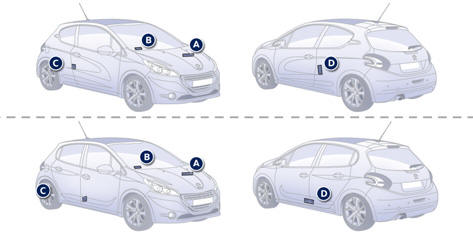Identifi cation markings
Various visible markings for the identification of your vehicle.

A. Vehicle Identification Number (VIN) under the bonnet. This number is engraved on the bodywork near the damper support.
B. Vehicle identification Number (VIN) on the windscreen lower crossmember. This number is indicated on a self-adhesive label which is visible through the windscreen.
C. Manufacturer's label. The VIN is indicated on a self-destroying label affixed to the middle pillar, on the passenger's side.
D. Tyre/paint label. This label is fitted to the middle pillar, on the driver's side.
It bears the following information:
- the tyre inflation pressures with and without load,
- the wheel rim and tyre sizes,
- the brands of tyre recommended by the manufacturer,
- the inflation pressure of the spare wheel,
- the paint colour code.
The tyre pressures must be checked when the tyres are cold, at least once a month.
Low tyre pressures increase fuel consumption.
See also:
General points relating to child seats
Although one of PEUGEOT's main criteria when designing your vehicle, the safety
of your children also depends on you.
For maximum safety, please observe the following recommendations:
- in acc ...
Diesel engines
The various caps and covers allow access for checking the levels of the various
fluids, for replacing certain components and for priming the fuel system.
1. Screenwash reservoir.
2. Coolant reserv ...
Overview
The Peugeot 3008 is a compact and spacious crossover. It represents a new and
innovative offer, not only in the Peugeot range but also in today's car market
as a whole. Manufactured in Eastern Fra ...






